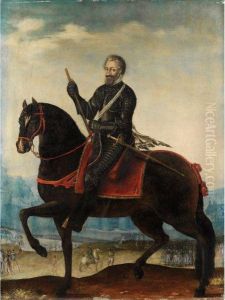Marin Le Bourgeoys Paintings
Marin Le Bourgeoys was not primarily known as an artist in the traditional sense of painters and sculptors of his time; rather, he was a French gunsmith and inventor, most recognized for his contribution to the development of firearms. Born around 1550 in Lisieux, Normandy, Le Bourgeoys came from a family with a background in metalwork and gunsmithing. This environment likely provided him with the foundational skills and interest in the mechanics and craftsmanship that would influence his later work.
Le Bourgeoys is best known for inventing the flintlock mechanism around the turn of the 17th century. The flintlock was a significant advancement in firearm technology and remained the predominant method of igniting firearms for over two centuries. The flintlock mechanism was more reliable and quicker to use than its predecessors, which included the matchlock and wheellock mechanisms. This invention earned him appointments from King Henry IV of France, and he became the royal gunsmith. His role extended under Louis XIII's reign, indicating his esteemed status and the high regard in which his skills were held.
Despite being a figure of historical importance in the context of weaponry, Le Bourgeoys remains a somewhat elusive figure with limited personal documentation surviving. What is known is that his work had a lasting impact on military technology and the development of firearms. The flintlock mechanism was not only used in muskets and rifles but also in pistols and other small arms throughout the 17th and 18th centuries. Its influence spread across Europe and played a vital role in both military and civilian firearms construction.
Le Bourgeoys continued to serve the French court until his death in 1634. While his contributions to the art of gunsmithing are well noted, there is less information on his life outside his professional achievements. Nevertheless, his legacy as an inventor and craftsman has cemented his place in the history of firearms development, and his work is considered an art form by those who appreciate the intricate design and mechanical ingenuity of historic weaponry.
